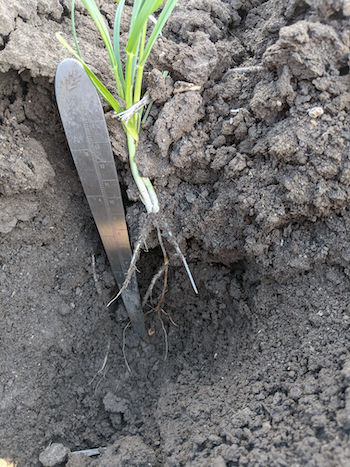Key points
- A combination of soil temperature, seed quality and coleoptile length can have a significant effect on wheat emergence
- First-year trial results show deep-sown winter cereals can, under the right conditions, compensate for poor establishment,
- 2021 trial work has helped to highlight how well long coleoptile wheats could perform if sown at the right time
Research to validate the potential benefits of long coleoptile wheat (LCW) lines in the northern grains region is highlighting how compensatory winter cereals can be.
Queensland Department of Agriculture and Fisheries (DAF) senior regional research agronomist Darren Aisthorpe is leading the project, which began in April 2021. “Our first year of data has helped highlight how amazingly compensatory winter cereals are in the right environment, with the potential to revolutionise the region’s cropping system,” he says.
Trials
Mr Aisthorpe and the DAF regional research agronomy team began the GRDC and DAF-invested project to better understand factors that affect the emergence and establishment of wheat containing the long coleoptile trait in south-western and Central Queensland.
“We wanted to accentuate the soil temperature differences at emergence, so sowing dates were spread about a month apart,” Mr Aisthorpe says. The earliest sowing date for 2021 was 19 April at Emerald.
Two other time of sowing (TOS) dates were planted on 20 May and 17 June, along with single sowing date trials at Condamine and north-east of Goondiwindi in mid-May.
All trials for the 14 long coleoptile and standard wheat lines, and one barley line, were sown at two depths – a shallow depth with three to five centimetres of soil over the seed, and a deeper depth with about 12cm of soil over the seed.
Mr Aisthorpe says that both sowing depth and soil temperature are important research factors in Central Queensland and across much of the heavier clay-type vertosol cropping country found in the northern region.
Deep sowing allows growers to access moisture stored in the soil, instead of waiting for planting rains. However, sowing varieties with shorter coleoptile lengths too deep can cause poor establishment, as the coleoptile is unable to reach the soil surface.
 Image shows the depth the long coleoptile lines were planted in the deep trials at Emerald. Photo: Supplied by Darren Aisthorpe
Image shows the depth the long coleoptile lines were planted in the deep trials at Emerald. Photo: Supplied by Darren Aisthorpe
Soil temperature can also affect establishment and was another reason Mr Aisthorpe was keen to try earlier planting dates. CSIRO research by Dr Greg Rebetzke and his team has shown that when average soil temperatures exceed 20°C during the emergence period, some varieties’ coleoptile lengths can shorten by as much as 30 per cent of their potential.
Emergence
Not unexpectedly, the deep-sown treatments in the 2021 Central Queensland trials had a disappointing emergence. Post-sowing, the seed source confirmed that storage issues meant the LCW lines were not as high-vigour as first thought.
While the establishment for shallow-sown lines in TOS1 was excellent, the deep-sown treatments only averaged 20 per cent of the target populations – a “disaster”, Mr Aisthorpe says. “We are talking 20 to 30 plants per square metre average across most lines, when the ideal is 100 plants per square metre.
“We suspect soil temperature was the main culprit. Average shallow soil temperatures during emergence were 21.6oC, while the deep averaged 22.7oC. This is well above Greg Rebetzke’s data, which indicated a sweet spot around the 15oC mark.”
Plant population
In the commercial world, he says, such a poor establishment would probably have been sprayed out. “However, phenology is a funny thing and some interesting things started to occur.”
Despite the poor plant establishment, by the time the emerged population reached flowering, the number of viable tillers per square metre was not as low as the research team was expecting.
The shallow plots in TOS1 had 250 tillers per square metre. Just behind those were the TOS1 deep plots at 210 tillers per square metre.
“The April-sown plants showed they had enormous compensatory ability while developing in the milder, lower-stress conditions. And, sure enough, at harvest the yield results were pretty remarkable too.
“As expected, the TOS1 shallow plots were statistically the highest-yielding, but TOS1 deep plots were statistically higher-yielding than the shallow-planted May or June plots. All this was achieved with 70 millimetres of in-crop rainfall, the majority of which fell between late April and early July.
“The multiple sowing dates allowed us to see how amazingly compensatory these plants are when in a lower-stress environment, something we have seen anecdotally for years. That is, plant deep earlier rather than later.
Time of sowing (TOS) and emergence, viable tillers and yield

Source: Darren Aisthorpe
Buoyed by the results, Mr Aisthorpe says there are still many questions to answer.
“This is only the first year of the project, but despite the challenge of higher soil temperatures, the benefits of deep sowing earlier rather than later – with high-quality, longer-coleoptile varieties – could revolutionise our cropping system.”
More information: Darren Aisthorpe, 07 4991 0808, darren.aisthorpe@daf.qld.gov.au

























































